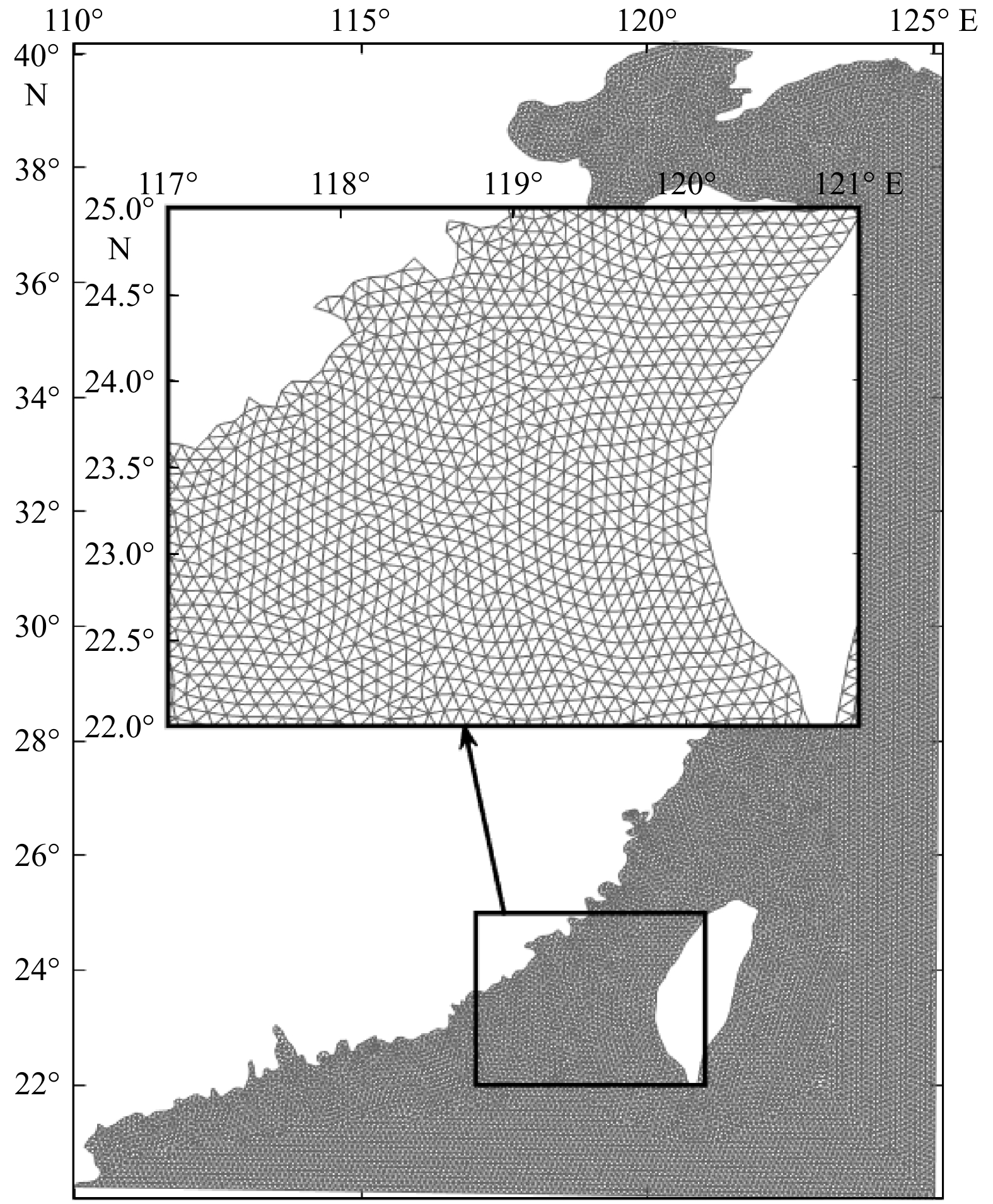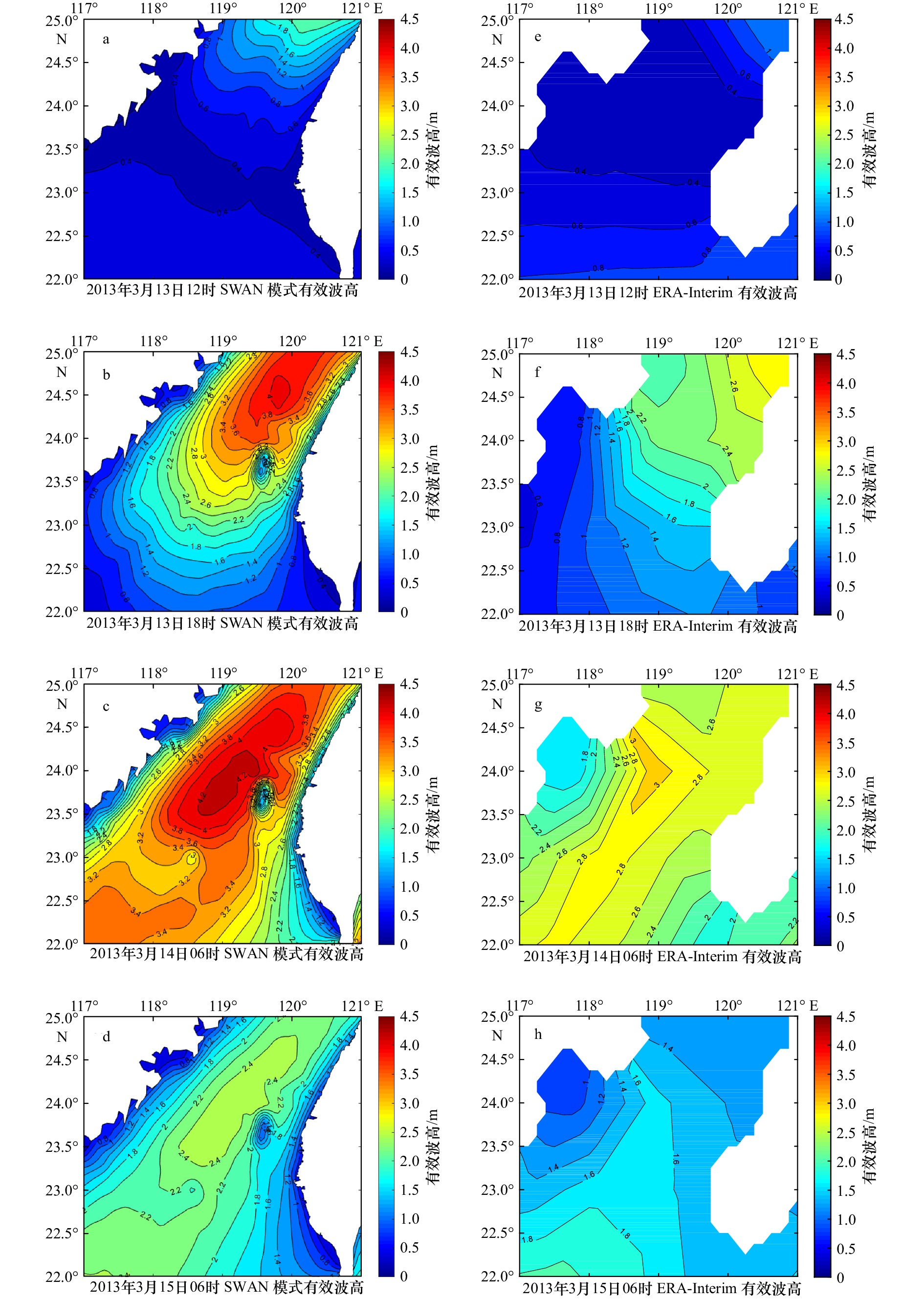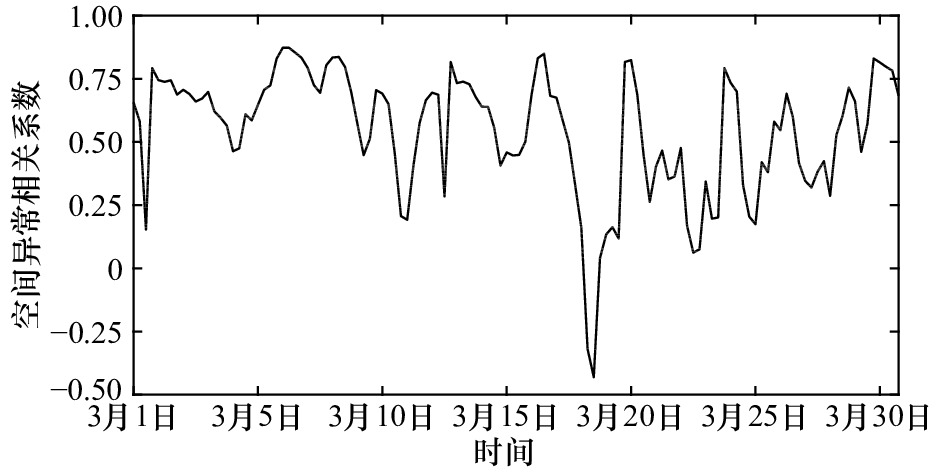Comparative analysis of SWAN model and ERA-Interim data on significant wave height in the Taiwan Strait
-
摘要: 有效波高是描述海浪的关键参数。欧洲中期天气预报中心(ECMWF)提供的ERA-Interim再分析数据提供了全球海浪的有效波高,本文选取该数据在台湾海峡2013年3月份的有效波高结果,分别与浮标观测数据以及海浪数值模式SWAN (Simulating Waves Nearshore)的数值模拟结果相对比,来分析其预报效果。结果显示:在浮标点,ERA-Interim数据和SWAN模拟浪高数据与浮标浪高数据的时间相关系数分别为0.94和0.98,ERA-Interim数据的浪高均值约为浮标的51%,为SWAN模拟数据的70%。在台湾海峡区域,ERA-Interim数据与SWAN模拟浪高之间的空间异常相关系数(ACC)月均值为0.51,时序ACC曲线显示,一般在海峡东北口风初起时刻ACC值最小,在风吹遍海峡并增长的过程中,ACC迅速增加,在风速达到最大值之后,ACC开始下降,但ERA-Interim数据与SWAN数值模拟结果在整个海峡区域的浪高最大值与最小值分布位置基本一致。综合分析,ERA-Interim数据能够反映台湾海峡区域此时间段的有效波高的时空变化趋势,在数值上有明显低估。
-
关键词:
- ERA-Interim数据 /
- SWAN /
- 浮标 /
- 台湾海峡 /
- 有效波高
Abstract: The significant wave height (SWH) is a key parameter for describing the ocean waves. In this paper, the SWH in the Taiwan Strait provided by the ERA-Interim reanalysis data from the European Centre for Medium-Range Weather Forecasts (ECMWF) in March 2013 is compared with the buoy observations and the simulation results of the SWAN (Simulating Waves Nearshore) model. The results showed that the correlation coefficient of SWH between the buoy data and the ERA-Interim as well as the SWAN results is 0.94 and 0.98, respectively. The average SWH of the ERA-Interim data is about 51% of the buoy data and 70% of the SWAN results. The monthly averaged values of the spatial anomaly correlation coefficient (ACC) of the SWH between the ERA-Interim data and the SWAN results is 0.51. The ACC was minimal when the wind started, it boosted rapidly with increasing of the wind speed and reached the maximum before the wind speed reached the peak. Then the ACC turned to decrease at the peak wind speed. Integrated analysis imply that the ERA-Interim data can reflect the spatial distribution and the temporal variations trend of the SWH over the Taiwan Strait during this period, but it’s evidently smaller than the SWAN model data.-
Key words:
- ERA-Interim data /
- SWAN /
- buoy /
- Taiwan Strait /
- significant wave height
-
表 1 不同风场条件下SWAN数值模拟结果与浮标观测结果比较
Tab. 1 Comparison of SWAN numerical simulation results and buoy observation results under different wind field conditions
风场类型 风速U
范围/(m·s−1)相关系数 二者差值 /m 最大值 均值 RMS 弱风 0≤U≤5 0.90 0.60 0.15 0.18 中风 5<U≤12 0.93 1.29 0.34 0.46 强风 U>12 0.90 1.20 0.28 0.42 表 2 浮标点与周围4个ERA-Interim数据点有效波高对比
Tab. 2 Comparison of the significant wave height between the buoy point and the surrounding 4 ERA-Interim data points
数据点信息 有效波高差值/m 坐标 水深/m 最大值 均值 RMS 23.750°N, 118.125°E 32.42 2.13 0.72 0.95 23.625°N, 118.125°E 35.41 2.10 0.68 0.90 23.625°N, 118.250°E 42.90 2.01 0.63 0.83 23.750°N, 118.250°E 39.54 2.04 0.67 0.88 表 3 浮标点3种方式得到的有效波高月均值、最大值以及与CCMP风速相关系数的对比
Tab. 3 Comparison of the significant wave height monthly averaged values, maximum values and correlation coefficients with the CCMP wind speed obtained by three methods
浮标 SWAN模式 ERA-Interim 均值/m 1.55 1.30 0.88 最大值/m 4.87 3.98 2.63 相关系数 0.92 0.94 0.91 表 4 不同风场条件下浮标数据与ERA-Interim数据有效波高值比较
Tab. 4 Comparison of significant wave height between buoy data and ERA-Interim data under different wind conditions
风场类型 风速U
范围/(m·s−1)相关系数 二者差值/m 最大值 均值 RMS 弱风 0≤U≤5 0.56 0.81 0.19 0.27 中风 5<U≤12 0.85 1.83 0.99 1.06 强风 U>12 0.88 2.00 1.25 1.35 -
[1] 管长龙. 我国海浪理论及预报研究的回顾与展望[J]. 青岛海洋大学学报, 2000, 30(4): 549−556.Guan Changlong. A review of history and prospect for study of sea wave theory and its forecast in China[J]. Journal of Ocean University of Qingdao, 2000, 30(4): 549−556. [2] 刘金芳, 刘忠, 顾翼炎, 等. 台湾海峡水文要素特征分析[J]. 海洋预报, 2002, 19(3): 22−32. doi: 10.3969/j.issn.1003-0239.2002.03.003Liu Jinfang, Liu Zhong, Gu Yiyan, et al. Analysis of the hydrographic elements features in Taiwan Strait[J]. Marine Forecasts, 2002, 19(3): 22−32. doi: 10.3969/j.issn.1003-0239.2002.03.003 [3] Chuang W S. A note on the driving mechanisms of current in the Taiwan Strait[J]. Journal of Oceanography, 1986, 42(5): 355−361. doi: 10.1007/BF02110430 [4] Jan S, Sheu D D, Kuo H M. Water mass and throughflow transport variability in the Taiwan Strait[J]. Journal of Geophysical Research: Oceans, 2006, 111(C12): C12012. doi: 10.1029/2006JC003656 [5] 姬厚德, 蓝尹余, 赵东波. SWAN在台湾海峡台风浪场数值模拟中的应用研究[J]. 水道港口, 2013, 34(2): 113−117. doi: 10.3969/j.issn.1005-8443.2013.02.007Ji Houde, Lan Yinyu, Zhao Dongbo. Application of SWAN in Taiwan Strait typhoon waves numerical simulation[J]. Journal of Waterway and Harbour, 2013, 34(2): 113−117. doi: 10.3969/j.issn.1005-8443.2013.02.007 [6] 袁凯瑞, 商少平, 谢燕双, 等. 台湾海峡台风浪的数值模拟[J]. 厦门大学学报(自然科学版), 2014, 53(3): 413−417.Yuan Kairui, Shang Shaoping, Xie Yanshuang, et al. The simulation of typhoon waves in Taiwan Strait[J]. Journal of Xiamen University (Natural Science), 2014, 53(3): 413−417. [7] Li Chuan, Wu Xiongbin, Yue Xianchang, et al. Extraction of wind direction spreading factor from broad-beam high-frequency surface wave radar data[J]. IEEE Transactions on Geoscience and Remote Sensing, 2017, 55(9): 5123−5133. doi: 10.1109/TGRS.2017.2702394 [8] 吴雄斌, 李伦, 李炎, 等. 高频地波雷达海面有效波高探测实验研究[J]. 海洋与湖沼, 2012, 43(2): 210−216. doi: 10.11693/hyhz201202002002Wu Xiongbin, Li Lun, Li Yan, et al. Experimental research on significant waveheight detecting with HFSWR OSMAR071[J]. Oceanologia et Limnologia Sinica, 2012, 43(2): 210−216. doi: 10.11693/hyhz201202002002 [9] Wu Xiongbin, Yang Shaolin, Cheng Feng, et al. Ocean surface current detection by HF surface wave radar at the Eastern China Sea[J]. Chinese Journal of Geophysics, 2003, 46(3): 489−498. doi: 10.1002/cjg2.3366 [10] 叶雨颖. 台湾海峡风浪场的数值模拟研究[D]. 厦门: 厦门大学, 2006.Ye Yuying. The numerical simulation of wind waves in Taiwan Strait[D]. Xiamen: Xiamen University, 2006. [11] 姬厚德. 台湾海峡及附近港湾的风浪场数值模拟研究[D]. 厦门: 厦门大学, 2007.Ji Houde. The numerical simulation of wind waves in Taiwan Strait and Harbors nearby[D]. Xiamen: Xiamen University, 2007. [12] 陈希, 沙文钰, 闵锦忠. 台湾岛邻近海域台风浪的模拟研究[J]. 海洋预报, 2002, 19(4): 1−10. doi: 10.3969/j.issn.1003-0239.2002.04.001Chen Xi, Sha Wenyu, Min Jinzhong. The simulation of typhoon waves around Taiwan Island[J]. Marine Forecasts, 2002, 19(4): 1−10. doi: 10.3969/j.issn.1003-0239.2002.04.001 [13] 陈希, 闵锦忠, 李妍, 等. 台湾岛邻近海域台风浪模拟分析[J]. 气象科学, 2003, 23(1): 46−54. doi: 10.3969/j.issn.1009-0827.2003.01.006Chen Xi, Min Jinzhong. Li Yan, et al The simulation of typhoon waves around Taiwan Island[J]. Scientia Meteorologica Sinica, 2003, 23(1): 46−54. doi: 10.3969/j.issn.1009-0827.2003.01.006 [14] 滕陈轲敏, 岳显昌, 吴雄斌, 等. 风场对SWAN模式在台湾海峡后报结果的影响[J]. 海洋学报, 2019, 41(5): 59−69.Teng Chenkemin, Yue Xianchang, Wu Xiongbin, et al. Impacts of wind data on the hindcast of wave height simulated by SWAN model on the Taiwan Strait[J]. Haiyang Xuebao, 2019, 41(5): 59−69. [15] Christakos K, Furevik B R, Aarnes O J, et al. The importance of wind forcing in fjord wave modelling[J]. Ocean Dynamics, 2020, 70(1): 57−75. doi: 10.1007/s10236-019-01323-w [16] 丁磊, 于博. SWAN模型中不同风拖曳力系数对风浪模拟的影响[J]. 海洋学报, 2017, 39(11): 14−23.Ding Lei, Yu Bo. Impact of wind drag coefficients on wave simulation using SWAN model[J]. Haiyang Xuebao, 2017, 39(11): 14−23. [17] Wang Zhifeng, Li Songtao, Hao Yan, et al. Estimation and prediction of typhoons and wave overtopping in Qingdao, China[J]. Journal of Ocean University of China, 2020, 19(5): 1017−1028. doi: 10.1007/s11802-020-4378-4 [18] Dee D P, Uppala S M, Simmons A J, et al. The ERA-Interim reanalysis: Configuration and performance of the data assimilation system[J]. Quarterly Journal of the Royal Meteorological Society, 2011, 137(656): 553−597. doi: 10.1002/qj.828 [19] Kumarl V S, Naseef T M. Performance of ERA-Interim wave data in the nearshore waters around India[J]. Journal of Atmospheric and Oceanic Technology, 2015, 32(6): 1257−1269. doi: 10.1175/JTECH-D-14-00153.1 [20] Shanas P R, Kumar V S. Temporal variations in the wind and wave climate at a location in the eastern Arabian Sea based on ERA-Interim reanalysis data[J]. Natural Hazards and Earth System Sciences, 2014, 14(5): 1371−1381. doi: 10.5194/nhess-14-1371-2014 [21] 万勇, 张杰, 孟俊敏, 等. 基于ERA-Interim高分辨率数据的中国东海南海波浪能评估[J]. 太阳能学报, 2015, 36(5): 1259−1267. doi: 10.3969/j.issn.0254-0096.2015.05.036Wan Yong, Zhang Jie, Meng Junmin, et al. Wave energy assessment in the East China sea and South China Sea based on ERA-Interim high resolution data[J]. Acta Energiae Solaris Sinica, 2015, 36(5): 1259−1267. doi: 10.3969/j.issn.0254-0096.2015.05.036 [22] 王小丹, 赵文静. 基于ERA-Interim再分析资料的南沙海域风、浪场特征分析[J]. 海洋预报, 2019, 36(2): 30−37. doi: 10.11737/j.issn.1003-0239.2019.02.004Wang Xiaodan, Zhao Wenjing. Characteristics analysis of wind and wave in the Nansha Aera based on ERA-Interim reanalysis data[J]. Marine Forecasts, 2019, 36(2): 30−37. doi: 10.11737/j.issn.1003-0239.2019.02.004 [23] Islek F, Yuksel Y. Inter-comparison of long-term wave power potential in the Black Sea based on the SWAN wave model forced with two different wind fields[J]. Dynamics of Atmospheres and Oceans, 2021, 93: 101192. doi: 10.1016/j.dynatmoce.2020.101192 [24] 陈雅雅, 邹仲水, 赵栋梁. 基于SWAN模式的台风浪数值模拟初步研究[J]. 海洋湖沼通报, 2017(6): 1−10.Chen Yaya, Zou Zhongshui, Zhao Dongliang. A preliminary study of typhoon wave based on numerical simulations using SWAN model[J]. Transactions of Oceanology and Limnology, 2017(6): 1−10. [25] 麻巨慧, 朱跃建, 王盘兴, 等. NCEP、ECMWF及CMC全球集合预报业务系统发展综述[J]. 大气科学学报, 2011, 34(3): 370−380. doi: 10.3969/j.issn.1674-7097.2011.03.015Ma Juhui, Zhu Yuejian, Wang Panxing, et al. A review on the developments of NCEP, ECMWF and CMC global ensemble forecast system[J]. Transactions of Atmospheric Sciences, 2011, 34(3): 370−380. doi: 10.3969/j.issn.1674-7097.2011.03.015 [26] Booij N, Haagsma I J G, Holthuijsen L H, et al. SWAN cycle III version 41.31A users manual[M]. Delft, The Netherlands: Delft University of Technology, 2004: 115. [27] 潘番. 渤海海浪SWAN计算模式及波浪反射的研究[D]. 天津: 天津大学, 2013.Pan Fan. Research on calculation model and reflection simulation for wave in Bohai Sea by SWAN[D]. Tianjin: Tianjin University, 2013. [28] Yan Yixin, Xu Fumin, Mao Lihua. A new type numerical model for action balance equation in simulating nearshore waves[J]. Chinese Science Bulletin, 2001, 46(11): 963−968. doi: 10.1007/BF02900477 [29] Du Jianting, Bolaños R, Larsén X G. The use of a wave boundary layer model in SWAN[J]. Journal of Geophysical Research: Oceans, 2017, 122(1): 42−62. doi: 10.1002/2016JC012104 [30] Group S S. Surface Water Modeling System (SMS)[EB/OL]. (2006–04–15)[2020–09–15]. https://doi.org/10.1002/0470848944.hsa288. [31] 薛立梅. SMS系统软件在水利工程中的应用[J]. 东北水利水电, 2010, 28(11): 63, 68.Xue Limei. Application of SMS system software in hydro project[J]. Water Resources & Hydropower of Northeast China, 2010, 28(11): 63, 68. [32] 张鹏, 陈晓玲, 陆建忠, 等. 基于CCMP卫星遥感海面风场数据的渤海风浪模拟研究[J]. 海洋通报, 2011, 30(3): 266−271. doi: 10.3969/j.issn.1001-6392.2011.03.005Zhang Peng, Chen Xiaoling, Lu Jianzhong, et al. Research on wave simulation of Bohai Sea based on the CCMP remotely sensed sea winds[J]. Marine Science Bulletin, 2011, 30(3): 266−271. doi: 10.3969/j.issn.1001-6392.2011.03.005 [33] Huang Yong, Weisberg R H, Zheng Lianyuan, et al. Gulf of Mexico hurricane wave simulations using SWAN: Bulk formula-based drag coefficient sensitivity for Hurricane Ike[J]. Journal of Geophysical Research: Oceans, 2013, 118(8): 3916−3938. doi: 10.1002/jgrc.20283 [34] 孟凡昌. 强海况下的波流相互作用研究[D]. 北京: 国家海洋环境预报中心, 2017.Meng Fanchang. Study on wave-current interaction under strong sea conditions[D]. Beijing: National Marine Environmental Forecasting Center, 2017. [35] 宗芳伊, 吴克俭. 基于近20年的SWAN模式海浪模拟结果的南海波浪能分布、变化研究[J]. 海洋湖沼通报, 2014(3): 1−12.Zong Fangyi, Wu Kejian. Research on distributions and variations of wave energy in South China Sea based on recent 20 years' wave simulation results using SWAN wave model[J]. Transactions of Oceanology and Limnology, 2014(3): 1−12. [36] 黄必桂. 渤海海浪的数值模拟和涌浪对风浪影响的研究[D]. 青岛: 中国海洋大学, 2009.Huang Bigui. Numerical simulation of waves in Bohai Sea and research on the influence of swells on wind waves[D]. Qingdao: Ocean University of China, 2009. -





 下载:
下载:





